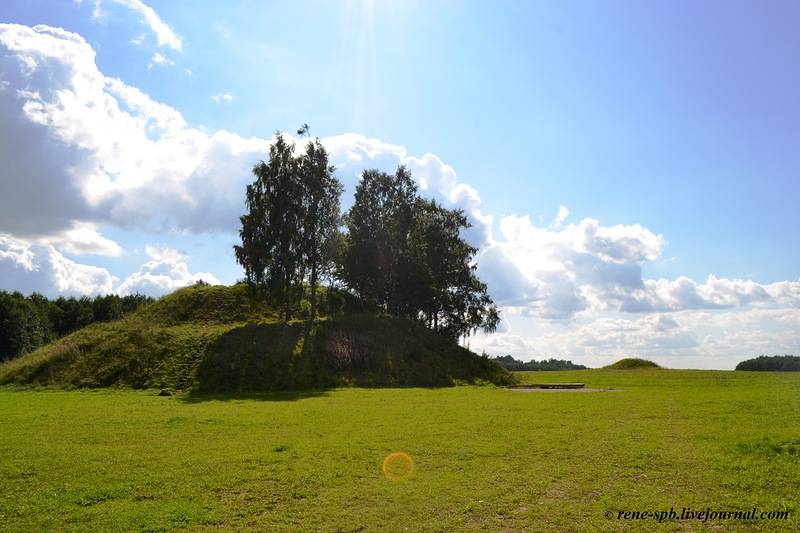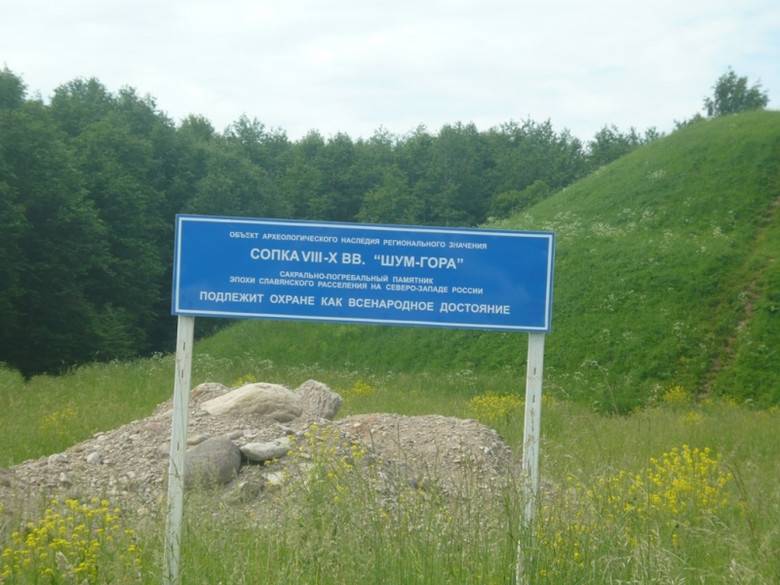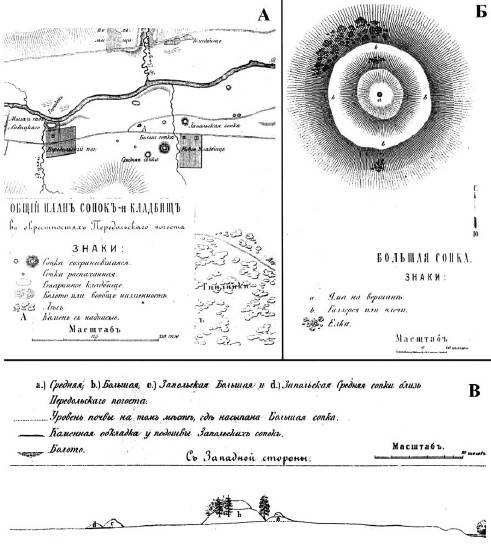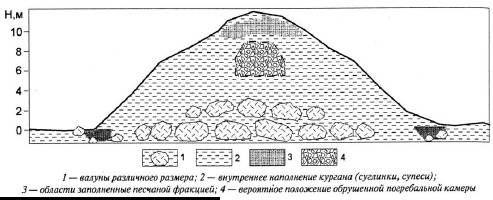Noise Mountain: Mstislav Castle or the grave of Rurik?
Sometimes, we ran away for a day or more, taking with us fishing rods, half a loaf of bread and a matchbox with salt, feeding on caught fish, berries, mushrooms and other pasture in the forest. The nights spent by the fire in a pine forest on the high bank of the Luga, even now when I write this text, make me sigh nostalgically ...
On one of these nights, I first heard from one of the boys, who was three or four years older than me, history about the grave of Rurik. Actually, I heard about Ryurik, probably for the first time. And he told us that somewhere here, on the banks of the Luga, the first Russian prince who died in the battle with the enemies was buried, that a huge barrow was piled on his grave, and huge treasures were buried in the grave itself, along with Rurik lying in a golden coffin : gold, precious stones and, most importantly, weapon and armor. And if we had found this grave, then ... Appear in the village in glittering mail and a helmet with rubies and emeralds, with a real shining steel sword in hand ... It would be the greatest triumph that we would never forget! We spent the rest of the night in our dreams about how we would manage the found treasures.
The first thing I did when I got home was that I was populated with questions about the adults and grandmothers and grandfathers who came across my arm in order to secretly find out from them where to look for Rurik's grave. To my great disappointment, as soon as the name Rurik sounded in the conversation, the mystery was revealed. It turns out that all the adults knew where his mound was located - about forty kilometers from our village, and this information was not a secret. Approximately the same information was received by my comrades from their grandfathers and dads. The treasure hunts were recognized as inexpedient and until the end of childhood we treated only with wooden swords, which did not prevent us from chopping them in forest glades and village streets. Rurik's grave was safely forgotten.
As time went on, I was seriously interested in the study of historical science. With only the emerging Internet, serious information could be obtained exclusively in the library, and I, during the preparation of essays, term papers and diplomas, did not forget to order one or two books on history, since the library to them. Mayakovsky in St. Petersburg allowed to take some of them home.
About ten years ago, with the company, returning from Novgorod to our native Luga, we decided not to drive along the Luga-Novgorod direct highway, but along the road along the Luga river, which in those places has the shape of a horseshoe, curved to the south. Driving past a small village located on the banks of the Luga, the name of which did not tell us anything, we suddenly saw a large hill to the left of the road in the middle of a clean field.

By that time, I had already been to Staraya Ladoga and had an idea of what the mounds looked like, and I didn’t cause any doubts about the fact that the mound looked like before me. Hit its height and volume. There are no such mounds even in Staraya Ladoga. We went out, looked around and at the foot of the mountain saw the following sign:

It was then that I remembered the grave of Rurik and expressed to his companions the hypothesis that this is exactly what she is. Arriving home, I immediately sat down at the computer and made sure that my guess was correct. It is to this hill that popular rumor attributes the honor of being the grave of the founder of the ancient Russian state.
Later, I remembered about Shum-gora more than once and periodically returned to searching for information about it in the hope that I would get the results of any scientific studies of this object, which, as I heard, were carried out already in our time. Not so long ago, during a regular controversy on the Military Review, I mentioned it, and after some deliberation it seemed to me that information about this object might be of interest to readers of “VO”.
So…
Sopka Shum-Gora is located on the southern bank of the Luga in its upstream between the villages of Zapolye and Podgorie of the Batetsky District of the Novgorod Region and is the central object of the Peredolsky Pogost, an ancient Slavic settlement. Sopka has an unprecedented height (about 14 meters) and a diameter at the base (about 75 meters), which is noticeably larger than even the “royal barrows” of Sweden and Norway.
For the first time, this hill and the objects adjacent to it were investigated and described in 1880 by the Russian archaeologist Mikhail Bystrov.

Further studies of Peredolsky Pogost were carried out in 1927, 1949 and 1959 years, during which the graveyard hills were described and classified.
In 1984, the archaeologist N.I. Platonov (Leading Researcher of the Department of Slavic-Finnish Archeology, IHMC RAS, Doctor of Historical Sciences), discovered a large settlement on the territory of the churchyard, and there is also an ancient settlement, which is difficult to study because it currently has a functioning cemetery.
Speaking about the researchers of the Peredolsky Pogost, it is impossible not to mention the brothers MS and ss The Aleksashins, local local history enthusiasts, thanks to whose activities the attention of the scientific community was attracted to Shum-gore.
Noise Mountain has not yet been studied in detail. More precisely, for her research in 2002-2005. only non-destructive methods were involved - georadar and seismographic, no excavations were carried out on the mountain. Refusal to conduct excavations for two reasons. The first is the need to preserve such a significant archaeological monument for posterity as it is, and the second lies in the area of the irrational - local people consider the hill to be a sacred place and fear that the opening of the mound can be aroused by some “forces” that they will have to “deal with” after leaving scientists. Remember the story of the autopsy of the grave of Tamerlane. The position of local residents supported (or supported) and the administration of the Batetsky district.
So, what do we know today about Noise-grief?
At present, it is precisely established that this is an artificial bulk structure, and it is heterogeneous in its composition. Numerous boulders are laid at the base of the structure, along the perimeter of the embankment there was a ditch, fortified with boulders, and in the center there is a certain anomaly, the nature of which currently does not have an unambiguous interpretation. A hypothesis is being put forward that does not yet have sufficient confirmation that this anomaly is a crumbling burial chamber and a passage to it, closed by a large boulder, as is typical of Viking burials. If this is so, then Shum-gora automatically becomes the largest mound in Europe, a mound, the likes of which were poured in quite extraordinary cases, for the funeral of the most senior persons. With reference to the Novgorod land, only Rurik can be such a special person in pre-Christian Russia. However, it is unfortunately impossible to talk about the presence of the Noise-Mountain inside the burial chamber with confidence.

Researchers V.Ya. Konetsky and S.V. Troyanovsky, from the article “The Great Hill of Peredolsky Pogost in the Context of the Socio-Political History of Novgorod at the Turn of the 11th-12th Centuries,” I gathered the most information about the studies of Shum-gory, put forward a different version of origin and the purpose of this structure.
Based on the appearance of the hill, its size and shape (bunk with a flat top), researchers believe that in relation to it we are dealing with a bulk structure of the “mott” type, that is, an embankment for the subsequent construction on it of a fortified point, castle, fortification.
Similar mounds are often found in Britain, Normandy, Germany, they were very popular in the XI-XII centuries in Western Europe and Scandinavia. By the possible construction time of Shum-gory, researchers determine the period of reigning in Novgorod of Mstislav Vladimirovich the Great (1088-1117), the prince of a very active, gifted and, most importantly, committed to Scandinavian culture. Despite the fact that the nearest structures of this type and purpose can be found only in Volyn, in the west of Ukraine, the researchers believe that the presence of such a structure in the Upper Half-Sea is quite acceptable. The objection that it is “too unique” for Russia is easily countered by the fact that he, as a “Mott”, even has analogues in Western Europe, and as a funerary structure with its size and shape of analogues it does not exist anywhere.
Thus, the question of the nature and purpose of Noise Mountain is currently open.
There is a mass of legends about Noise-grief, which the local population will willingly share with you, if you expressed a desire to listen to them. All of them boil down to the fact that the mountain protects itself from any invasions, up to a fatal outcome for the hapless "Tomb Raiders." I don’t see much point in bringing them in this article. I will only note that the fact that such an outstanding archaeological object has not yet been plundered by marauders, indirectly indicates that these legends may have certain grounds ...
I also see no point in citing the results of independent research of the Aleksashins mentioned above, since the artifacts that they collect around Peredolsky pogost (boulders with inscriptions, stone figures and other objects) do not inspire confidence in me, and their (or attributed to them) hypotheses, according to which Rurik is almost a relative of the Egyptian pharaohs, they strongly give to those that in general can be called "folk-history."
At the end of the article, I would like to quote a part of the folklore text from oral folk art, recorded in the vicinity of Shum-gory in the 19th century.
It is unlikely that this text can be of any benefit from the point of view of historical science, except perhaps for stating the fact that the legend that Rurik was buried precisely in Shum-gor has not already the first century of its existence.
It is possible that it has a rational grain ...
Использованная литература:
1. Konetsky V. Ya., Troyanovsky S. V. Bolshaya Sopka Peredolsky Pogost in the context of the social and political history of Novgorod at the turn of the XI-XII centuries.
2. Aleksashin S.S. Noise is a mountain. New data in the study of the cultural heritage monument.
3. Platonov N. I. About the burial rite of the Verkhneluzhsky hills (according to the materials of the Peredolsky Pogost).
Information